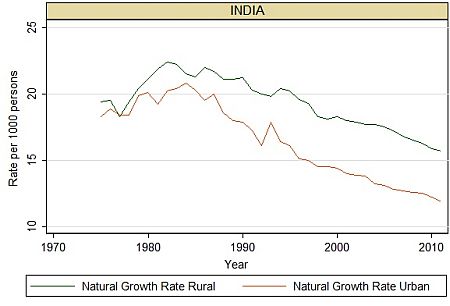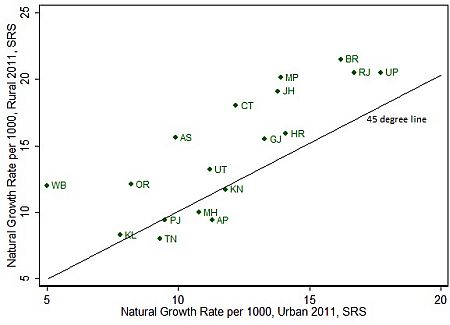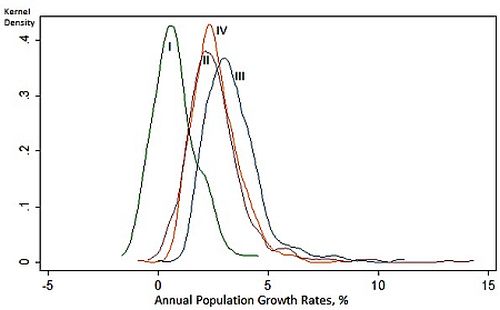Why is northern India experiencing faster urban growth but slower urbanisation relative to the South? This column addresses this question by highlighting the interconnection between the demographic transition and urban processes in India.
The Economic Survey of 2016-17 begins its chapter on ‘The Other Indias’ with a quote from Arvind Adiga’s novel: “India is two countries…Every place on the map of India near the ocean is well-off. But the river brings darkness to India.” This quote echoes what social scientists have known for at least two decades – the economic and demographic divide between peninsular India extending southwards, and the northern hinterland states of Rajasthan, Uttar Pradesh, Bihar, Madhya Pradesh, Jharkhand, and Chhattisgarh. In the South, per capita incomes and fertility rates are higher and lower respectively, than in the North. There is, however, an additional aspect of this regional difference that manifests itself in the pace of urban growth and urbanisation. The population of towns and cities in northern India is growing faster than in the South. Yet the pace of urbanisation, or the rise in the share of population living in urban areas, has been extremely slow in the North relative to the South. My recent IGC (International Growth Centre) study on urban dynamics in India since 1870 till date, using Census and other data sources, provides some clues towards addressing this paradox (Tumbe 2016).
Urbanisation dynamics
India’s urbanisation rate gradually rose from less than 9% in the 1870s to 17% in the 1950s and 31% in 2011. The urbanisation rates for the southern states are now inching towards the 50% mark while many of the northern states are still stuck at rates below 25%. My study shows a robust relationship between urbanisation and per capita income levels, and more importantly, growth rates over the past four decades at the sub-national level. However, India’s urbanisation rate is observed to be more than 10 percentage points lower than the rate predicted for its level of per capita income at the cross-country level. Further, the pace of urbanisation has been slower in India than in many other countries with similar or lower growth rates. India thus poses two challenges to urban trends: Why is the level of urbanisation low relative to its per capita income level, and why has the pace of urbanisation been slow in the last four decades despite relatively high economic growth rates?
Two explanations often discussed pertain to urban definitions and migration restrictions. India uses a conservative urban definition that assigns many settlements to be ‘rural’ when they would have been classified as ‘urban’ in other countries. A more liberal definition would raise the urbanisation rate and explain part of the difference between the actual urbanisation rate and the rate predicted at the corresponding per capita income level. The urbanisation rate in India in 2011 could vary between 31% based on the official definition and 47% if rural settlements with population exceeding 5,000 were classified as urban areas - a practice followed in many countries. However, my analysis reveals that irrespective of the definition used, the change in urbanisation rate between 2001 and 2011 remains constant at 3 percentage points. That is, a definition-based explanation addresses the issue of low urbanisation but not slow urbanisation.
Another explanation on the slow pace of Indian urbanisation focusses on low levels of spatial mobility. Census statistics on in-migration show low rates of mobility especially for non-marriage related reasons. However, as documented in Chapter 12 of the Economic Survey 2016-17, alternative estimates of migration reveal magnitudes of a much higher order such that at least 20% of the workforce can be considered to be migrant in nature.
Definition and migration-based explanations have overlooked another potential reason for India’s relatively slow pace of urbanisation. This is related with the fact that urbanisation also depends on rural-urban differences in natural growth rates which correspond to their respective demographic transitions.
The Demographic divergence
Figure 1 shows the remarkable demographic divergence between rural and urban natural growth rates over the past four decades. In the 1970s, birth and death rates were lower in urban areas but natural growth rates were identical in both rural and urban areas. Since then, rural and urban natural growth rates have diverged such that rural natural growth rates are now substantially higher than urban natural growth rates. This is a significant phenomenon as it indicates that in the absence of migration and reclassification effects, India has been de-urbanising for four decades. In other words, the demographic divergence has dragged down the pace of India’s urbanisation and needs careful scrutiny.
Figure 1. Rural-urban demographic divergence of natural growth rates, 1975-2011
 Source: Sample Registration System (SRS) statistics.
Source: Sample Registration System (SRS) statistics.
A clearer picture emerges in the state-level analysis. The southern states did not undergo the demographic divergence observed at the all-India level. In these states, the decline of rural and urban natural growth rates occurred at the same pace. This trend is also observed in the relatively richer states of Maharashtra and Gujarat in the West and Punjab in the North. The states that did undergo the demographic divergence are Bihar, Madhya Pradesh, Rajasthan, and Uttar Pradesh. As these states have a large demographic weight in India’s population, the divergence within these states translates into the overall divergence noted at the all-India level. Assam, a relatively poor north-eastern state also exhibits the demographic divergence.
A district-level analysis reveals that low rural literacy levels, and more importantly, low levels of agricultural productivity, are strongly associated with larger rural-urban fertility differentials and consequently larger rural-urban natural growth rate differentials. Agricultural productivity is negatively related with rural-urban fertility differentials even in a sub-sample of nearly 100 districts within the southern states, giving additional validity to the empirical results. I interpret these results as an income effect on fertility reduction whereby regions with stagnant agricultural productivity witness lower fertility reduction in rural areas relative to urban areas. Simulation analysis reveals that closing the rural-urban divide between natural growth rates would lead to an increase in urbanisation rates by over 4 percentage points, without any change in urban definition. This would explain nearly 50% of the observed gap between India’s official rate of urbanisation and that predicted at its level of income.
The rural-urban demographic divergence explains not only India’s slow pace of urbanisation but also why northern states have been urbanising slowly compared to the South. Yet, as Figure 2 shows, the levels of urban natural growth rates are substantially higher in the northern hinterland states than elsewhere. Since natural growth rates account for nearly 50% of overall urban growth rates, towns and cities in northern states are growing faster than those in the south, even as overall city-level population growth rates are falling on account of fertility reduction (Figure 3). The North-South urban paradox occurs because northern states have higher fertility rates in urban areas than in the South and also because they exhibit higher fertility rates in rural areas relative to urban areas. In simple words, northern towns and cities are growing faster but so are the villages!
Figure 2. State-level natural growth rates in rural and urban areas, 2011
 Source: SRS statistics.
Source: SRS statistics.
Figure 3. City population growth rate distributions across time periods, 1881-2011
 Source: Census 1881-2011. N=350+ agglomerations. Time Period I: 1881-1921, II: 1921-1951, III: 1951-1991, IV: 1991-2011.
Source: Census 1881-2011. N=350+ agglomerations. Time Period I: 1881-1921, II: 1921-1951, III: 1951-1991, IV: 1991-2011.
Implications of the North-South urban paradox
The North-South urban paradox has three important implications. First, unless agricultural productivity is boosted substantially in the northern hinterland states, the rural-urban demographic divergence will continue to stall the pace of urbanisation in India, especially in the northern hinterland states. Rural prosperity is thus demographically linked to the process of urbanisation. Second, in the next two decades, the bulk of urban population growth will occur in the northern states on account of higher fertility rates. Urban planning and infrastructure development projects and allocation of central government funds will need to take this demographic reality into account. Finally, fertility reduction is occurring at a rapid pace along the distribution of cities whereas migration tends to be disproportionately channelled towards the larger cities. As a result, city population growth rates will fall substantially for most towns and cities with important implications for city-level labour and housing markets and public finances.
Further Reading
- Ministry of Finance (2017), Economic Survey, 2016-17, Government of India, New Delhi.
- Tumbe, C (2016), ‘Urbanisation, Demographic Transition and the Growth of Cities in India, 1870-2020’, International Growth Centre (IGC) Working Paper C-35205-INC-1.




 22 March, 2017
22 March, 2017 




Comments will be held for moderation. Your contact information will not be made public.